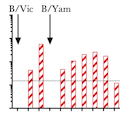Abstract
Background
Two influenza B virus lineages, B/Victoria and B/Yamagata, cocirculate in the human population. While the lineages are serologically distinct, cross-reactive responses to both lineages have been detected. Viral interference describes the situation whereby infection with one virus limits infection and replication of a second virus. We investigated the potential for viral interference between the influenza B virus lineages.
Methods
Ferrets were infected and then challenged 3, 10, or 28 days later with pairs of influenza B/Victoria and B/Yamagata viruses.
Results
Viral interference occurred at challenge intervals of 3 and 10 days and occasionally at 28 days. At the longer interval, shedding of challenge virus was reduced, and this correlated with cross-reactive interferon γ responses from lymph nodes from virus-infected animals. Viruses from both lineages could prevent or significantly limit subsequent infection with a virus from the other lineage. Coinfections were rare, indicating the potential for reassortment between lineages is limited.
Conclusion
These data suggest that innate and cross-reactive immunity mediate viral interference and that this may contribute to the dominance of a specific influenza B virus lineage in any given influenza season. Furthermore, infection with one influenza B virus lineage may be beneficial in protecting against subsequent infection with either influenza B virus lineage.
